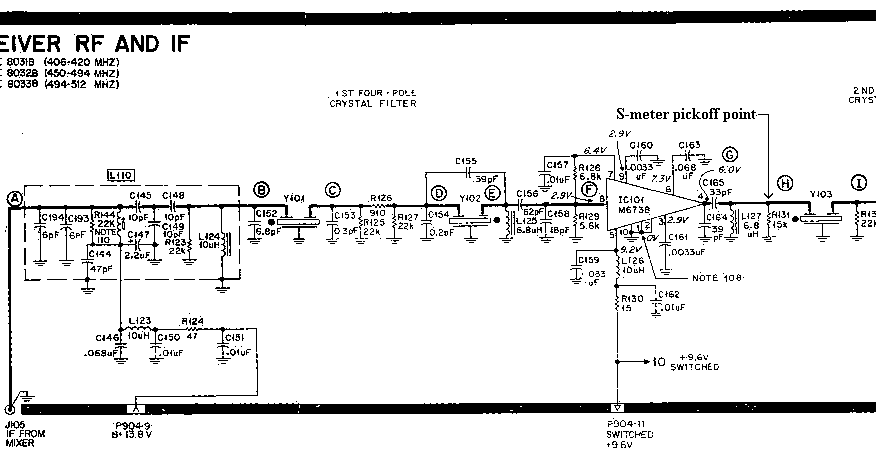Up two levels (Motorola Index)
Back to Home
HTML'd for repeater-builder by Mike Morris WA6ILQ

|
Up one level (MICOR Index) Up two levels (Motorola Index) Back to Home |
An Add-On S-Meter Circuit for Motorola® MICOR® Receivers HTML'd for repeater-builder by Mike Morris WA6ILQ |

|
Editors note by Mike WA6ILQ: I received the first, third and fourth image files below via email with no accompanying text. The artwork style of the opamp and of the meter face both suggest that is is an ACC design and is from an old issue of ACC Notes. I have credited it as such. I scanned the second image and wrote the text below from scratch. If anybody can locate the original ACC Notes text I will add it, and a reference to the original issue.
Concept:
Provide an analog s-meter output proportional to signal input. This DC voltage can
be fed to an analog input of a repeater controller. The controller can be programmed
to give an indication of signal strength, perhaps by varying the frequency of the
courtesy beep. Just remember that intermod, desense, and other extraneous RF noise
will falsify the reading.
Description:
Looking at the two schematics below you will see that the circuit point after the
first IF amplifier and before the second IF filter is identified as "Point H" on the
UHF schematic and as "Point J" on the VHF schematic. This is the point of interest.

Typical MICOR UHF IF amplifier schematic

Typical MICOR VHF IF amplifier schematic
The circuit below provides a dc voltage from near zero to just over 5 volts dc depending on signal input to allow a local meter or the ACC controller's S-meter input to be driven. A gain (calibration) pot is provided to allow the user to set the full-scale S-meter calibration as desired.

The 68pf capacitor provides DC isolation from the IF amplifier output, the two diodes and the 100pf capacitor produce the varying DC level, and the LM324 opamp acts as a variable gain buffer amplifier and prevents whatever load there is (an analog meter or the repeater controller analog input) from dragging down the DC level. Your target is a 0 to +5vDC voltage.
The 68pf capacitor may need to have its value adjusted for a 10m or 6m receiver. A low band MICOR uses 5.26 MHz for an IF frequency (or 5.36 if needed to dodge a birdie), whereas high band, UHF, 800 MHz and 900 MHz receivers use 11.7 (or 11.8) MHz.
Update, July 2009: This circuit needs more development to be really practical: Several people have reported trying several variations of this circuit and all have the problem that it loads down the IF strip (and therefore makes the receiver less sensitive). I would surmise that a high impedance RF amplifier needs to be inserted between the pick-off capacitor and the CR1 / CR2 rectifier.
Construction:
Construction can be simple breadboard wiring as the whole circuit will fit on a Radio
Shack 1 7/8" by 2 7/8" breadboard. The IC should be mounted in a socket to allow easy
replacement. You can power the circuit from a tap on the +9.6vDC buss in the receiver,
or use a 7808, 78M08 or 78L08 voltage regulator fed from +12vDC. The circuit should
not load the receiver in any way and should not degrade the receiver's performance.
Try to keep the lead from "Point H" (UHF) or "Point J" (VHF) reasonably short. You may
need to add some series resistance between the 68pf cap and the receiver IF tap point.
The two detector diodes (CR1 and CR2 should be germanium for best performance (germanium
has a lower voltage drop than silicon) and can be any signal diode. The board could be
mounted inside the receiver chassis, and you could use one of the unused frequency
select lines to bring the op-amp DC voltage output to the meter or to the controller
analog input.
After you have the DC voltage readback working you can program this meter face into your controller.

Jeff DePolo WN3A wrote:
The circuit is pretty basic, just sample the IF signal strength before the limiter
with a small-value capacitor, rectify it, and amplify/buffer it with a DC-coupled
op-amp circuit.
Because of the way the ACC does the S-meter, you'll never really get a real signal strength reading. It's calibrated from "S zero" to "S nine plus sixty". Assuming 6 dB per S-unit, that means there is better than 104 dB of dynamic range available, which in reality, would never be realized in an FM repeater. The other problem is that the ACC meter is scaled linearly, while real S-meters are logarithmic, so again, it's not all that accurate except for relative readings.
Since you'd be dealing with relative readings anyway, a better alternative is to
use noise level as an S-meter. But you don't need to build anything special; an
easy way to accomplish this would be to tap the signal corresponding to the
detected noise signal off the audio / squelch board squelch circuitry.
It should be pretty obvious if you look at the schematic and/or read Motorola's
thorough description of how the MICOR squelch works to figure out where to pick
it off. It should be a simple matter of conditioning that DC signal level for
interfacing to the ACC analog input.
--- Jeff
Back to the top of the page
Up one level (MICOR Index)
Up two levels (Motorola Index)
Back to Home
This page originally posted Sept-01-2005 and is © Copyright by Mike Morris WA6ILQ
This web page, this web site, the information presented in and on its pages and in these modifications and conversions is © Copyrighted 1995 or the date of posting and (date of last update) by Kevin Custer W3KKC and multiple originating authors. All Rights Reserved, including that of paper and web publication elsewhere.